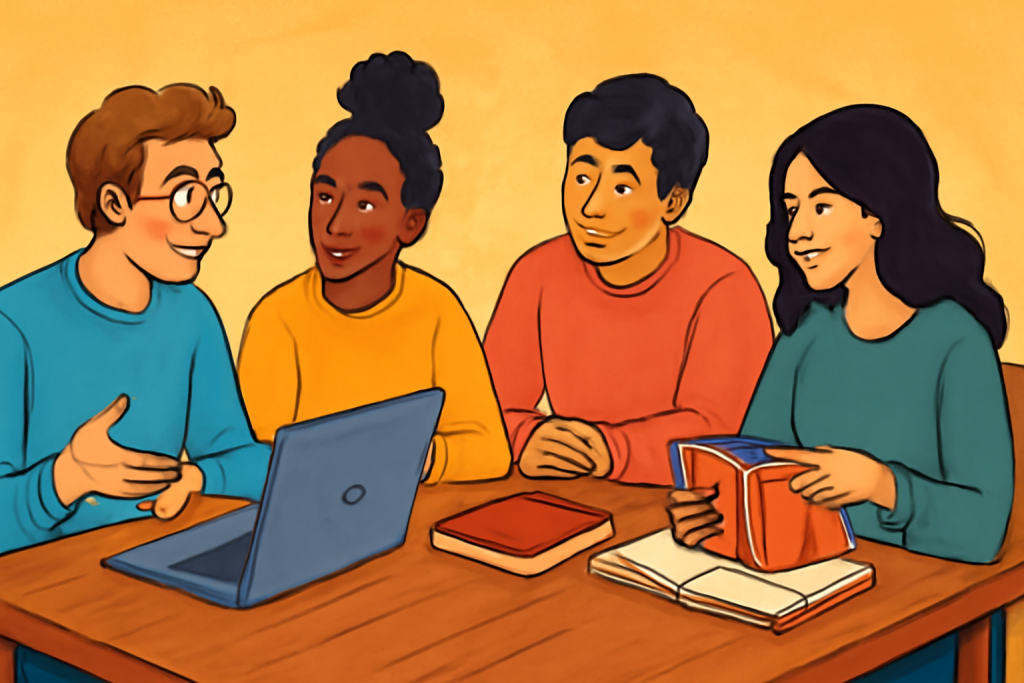Collaborative learning is rapidly becoming a cornerstone of modern education, reshaping how students engage with material, interact with peers, and prepare for future careers. This method emphasizes teamwork and shared responsibility, encouraging learners to actively participate rather than passively absorb information. In today’s interconnected world, the benefits of collaborative learning extend far beyond the classroom, fostering skills that are essential for success in life and work.

What is Collaborative Learning?
Collaborative learning is an educational strategy where students work together in groups or pairs to accomplish shared goals. Unlike traditional lecture-based teaching, where knowledge flows one-way from teacher to student, collaborative learning involves dialogue, cooperation, and collective problem-solving. Students share ideas, challenge one another’s thinking, and build knowledge through interaction.
This approach can take many forms, including group projects, peer tutoring, discussion groups, or even digital collaboration through online platforms. By working together, students can leverage diverse perspectives and skills, leading to a richer understanding of complex topics.
Why Collaborative Learning Matters Today
The modern workforce demands skills like communication, teamwork, and adaptability. Collaborative learning mirrors these real-world requirements, making it an effective way to prepare students for their professional lives. Moreover, educational research consistently highlights that students engaged in collaborative learning achieve better academic results and develop essential social-emotional skills.
Key Benefits of Collaborative Learning
1. Enhances Critical Thinking and Problem-Solving Skills
When students collaborate, they encounter different viewpoints and approaches to problem-solving. This exposure pushes them to analyze information critically, evaluate alternatives, and justify their ideas. The interactive nature of collaborative learning nurtures deeper cognitive processing compared to solitary study.
A study by Gulddal (2020) found that learners involved in group discussions showed significantly higher levels of critical thinking and analytical reasoning than those who studied alone (Gulddal 2020). By grappling with multiple perspectives, students become more adept at solving complex problems—a skill vital in academic and professional contexts.
2. Improves Communication Skills
Effective communication is fundamental to successful collaboration. Through group work, students practice articulating ideas clearly, listening to others, and giving constructive feedback. These skills enhance their ability to express themselves confidently in various settings.
Collaboration also teaches students to negotiate and manage disagreements constructively. Such interpersonal skills are highly sought after by employers who prioritize teamwork in the workplace.
3. Increases Student Engagement and Motivation
Learning in a collaborative environment tends to be more engaging. When students feel responsible for their contribution to the group, they are more motivated to participate actively. This sense of accountability can lead to improved attendance, attention, and overall enthusiasm for the subject.
Interactive group tasks break the monotony of traditional teaching methods, making learning more dynamic and enjoyable. This boost in motivation often translates into better academic performance.
4. Develops Social and Emotional Competence
Working in groups requires empathy, patience, and emotional regulation. Students learn to appreciate different viewpoints, accommodate diverse working styles, and resolve conflicts respectfully. These social-emotional competencies are crucial for personal development and help create a positive learning atmosphere.
Moreover, collaborative learning supports inclusivity by bringing together students with varying backgrounds and abilities, fostering mutual respect and understanding.
5. Prepares Students for Real-World Collaboration
Today’s workplace environments rarely require isolated work. Collaboration, project management, and teamwork are everyday demands. Collaborative learning simulates these real-world scenarios, giving students firsthand experience working in teams.
By practicing collaboration in school, students gain confidence and competence that translate directly into their careers. They learn how to balance different roles, share responsibilities, and work toward common objectives effectively.
How to Implement Collaborative Learning Effectively
Successful collaborative learning requires thoughtful planning and facilitation. Here are several strategies educators can use:
1. Structured Group Projects
Assigning group projects with clear objectives and roles encourages accountability and ensures that each member contributes meaningfully. Dividing tasks and setting deadlines help students develop organizational and time management skills.
2. Peer Teaching and Tutoring
Peer teaching empowers students to explain concepts in their own words, reinforcing their knowledge and boosting confidence. It also provides opportunities for learners who struggle with material to receive support from classmates in a relatable way.
3. Classroom Discussions and Debates
Organized discussions and debates promote critical thinking and help students practice respectful dialogue. These activities expose learners to diverse opinions and encourage them to support their arguments with evidence.
4. Use of Technology
Digital tools such as Google Docs, online forums, and collaborative apps enable students to work together asynchronously or synchronously, expanding opportunities for collaboration beyond the physical classroom. These technologies support real-time feedback and resource sharing.
Overcoming Challenges in Collaborative Learning
While the benefits are clear, collaborative learning comes with challenges that must be managed to maximize its effectiveness:
- Unequal Participation: Some students may dominate while others stay passive. Setting clear expectations and rotating roles can help ensure balanced involvement.
- Conflict Resolution: Differences in opinion can lead to tension. Teaching conflict management and fostering a culture of respect is essential.
- Assessment Difficulties: Fairly assessing individual contributions within a group can be complex. Combining peer evaluations with instructor assessments can provide a more accurate picture.
- Resource Constraints: Not all institutions have equal access to technology or materials needed for collaborative learning. Educators must adapt strategies to their context to ensure inclusivity.
The Future of Collaborative Learning
The rise of remote and hybrid learning models accelerated by recent global events has highlighted the importance of collaborative learning technologies. Virtual breakout rooms, collaborative platforms, and AI tools are making teamwork possible regardless of physical distance.
Additionally, cross-cultural and interdisciplinary collaborations are increasingly common, preparing students for a globalized workforce. The continuous evolution of collaborative learning practices promises to enhance education’s relevance and impact in the 21st century.
Conclusion
Collaborative learning offers a wide array of benefits that enrich education beyond traditional methods. It promotes critical thinking, communication, engagement, social-emotional growth, and real-world readiness. By embracing this approach, educators can equip students with the skills they need to succeed academically and professionally.
Though challenges exist, with proper planning and support, collaborative learning can be a transformative force in education, preparing learners for a complex and collaborative world.
References
- Gulddal, J. (2020) ‘That deep underground savage instinct: narratives of sacrifice and retribution in Agatha Christie’s Appointment with Death’, Textual Practice, 34(11), pp. 1803-1821.
- Thomas, D. and Tian, L. (2021) ‘Hits from the Bong: the impact of recreational marijuana dispensaries on property values’, Regional Science and Urban Economics, 87, article number 103655.
- Abu Salem, H., Gemail, K.S. and Nosair, A.M. (2021) ‘A multidisciplinary approach for delineating wastewater flow paths in shallow groundwater aquifers: A case study in the southeastern part of the Nile Delta, Egypt’, Journal of Contaminant Hydrology, 236, article number 103701.






